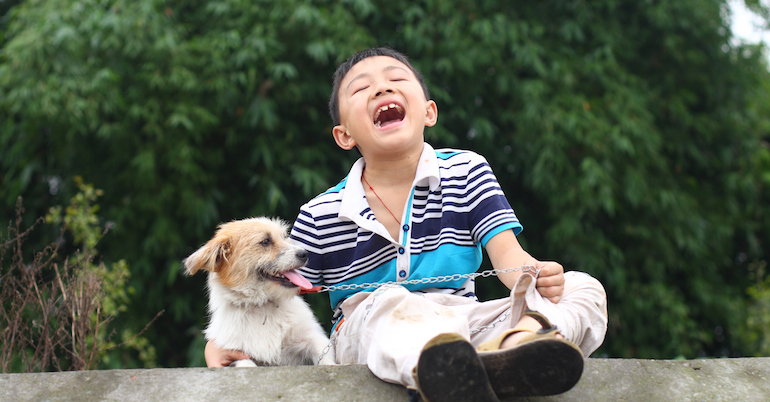Four-year-old Hana arrived from Ethiopia “ready to bond with her new family and full of affection, enthusiasm, and positive energy for life,” recalls mom Susan Poisson-Dollar. “I was relieved to see that she was a normal kid who’d been nurtured when she needed it.”
Poisson-Dollar credits Hana’s easy transition to two factors: “First, and most important, she clearly knew what a ‘mom’ was, and she wanted one again, badly. For that, I’m grateful to the aunt who raised her from six months of age. Second was the preparation I had made for the transition. I had scared myself silly with worst-case-scenario thinking, and so I was confident that I knew what to do when I saw that she was primed to attach.”
Despite the challenges of adjusting to a new language, new caregivers, and a new home, most children adopted internationally at toddler age and beyond do very well. As Poisson-Dollar and many others have found, bringing home an older child can be deeply rewarding for families if they have realistic expectations, flexible parenting strategies — and lots of patience.
Waiting Children, Waiting Parents
Although waiting-child adoptions are often expedited, the time between being approved to adopt and authorized to travel can be agonizing, because parents have a picture and profile in hand and know that the child is waiting for them. Parents can use this time to prepare for the child’s arrival — taking parenting and language classes, getting a room ready, reading books (see “For Your Bookshelf,” below), and educating family members about the child’s needs.
And, despite the distance between you and your child, there are ways to begin forging a bond during the waiting period. Sarah* and her husband adopted two sisters from India, ages three and six. She sent photo albums to the girls while they were in the orphanage to acquaint them with their new family, and these helped ease their transitions. “Our daughters knew exactly who we were, and recognized the house and the pets when they arrived home. They brought their albums with them and spent the first few days ‘matching’ things up.” Many online adoption groups offer ready-to-print files, so that parents can easily label photos in a child’s native language; a translation service can help you compose a reassuring letter.
After the Honeymoon
At the first meeting, an older child may be shy and reserved, happy and excited, or nervous and boisterous. For the next weeks or months, it’s common for families to have a “honeymoon” phase, during which the child stays on his best behavior. Then, as family members become more comfortable with each other, a child may begin to test his new parents’ limits, to see how much he can get away with.
Sometimes there are bouts of grief, confusion, or even rage over the child’s new circumstances.
After Ellen Margolese, a psychiatrist in Toronto, had been home several months with her four-year-old son, Kang Kang, he fell asleep in the car one afternoon. “Napping was unusual for him,” she says. “And when he woke, he whimpered and cried inconsolably. When I asked him what was wrong, he just shook his head. Later, when we sat down with a DVD of a cartoon he had watched in China with his foster family, he returned to his usual self. But halfway through, he turned to me and asked, ‘I stay here why?’
“Now, how do you answer that? He was too young, and knew too little English, to understand explanations about orphanages, foster homes, and adoption. I guess he felt I had kidnapped him and was keeping him from his beloved foster family.” After several months, during which he appeared to be adjusting well, confusion over all that he had lost seemed to emerge.
Parents may be surprised to see how deeply a child can grieve his losses. An institution, whether it was good or bad, may have been the only home a child has known. He may miss familiar routines and people, especially foster parents and friends. Though rough patches are usually brief, adjustment problems are sometimes severe enough to warrant professional help. Sarah says, “Our older daughter had a classic honeymoon. Then the rages started. They didn’t happen every day, but they were intense when they did. Eventually, we started counseling with a professional, and it was amazing to see the progress she made in less than a year.”
Generally, however, grief is a positive sign. It means that a child formed strong attachments in her home country — and is emotionally equipped to form attachments again.
Daily Adjustments
Children arriving from other cultures need time to adapt to your family’s habits and rhythms. Preserving some element of a child’s previous life can help smooth the transition. “Routine was very important to my kids. To this day, we eat lunch at noon and dinner at 6 p.m. That kept their schedule the same as it was at the children’s home, and it worked for us,” says Robyn Goldman, who adopted five-, seven-, and 13-year-old girls from Russia. (Find more real-life advice, in “Five Tips from the Trenches,” below.)
Don’t underestimate the significance of dietary changes. Smell and taste are evocative senses, and a child who is stressed can take comfort in familiar foods. Though some children eat new foods willingly, don’t expect a child to enthusiastically sit down to a meal of hot dogs and apple pie right off the bat. Cooking a child’s favorite foods, or making weekly visits to a restaurant that serves his home cuisine, can ease his transition.
Language differences may be the greatest challenge for everyone at first. “It was especially hard for our older daughter, who was six when we brought her home,” says Sarah. “She and her sister are both quite chatty, and were just dying to communicate. The older one was reading and writing a little in Hindi, and talked constantly. I learned some spoken Hindi, which got basic points across, but I wish I had known more. They both learned English at an amazing pace, though, so language wasn’t a problem for long.”
Although children learn to communicate basic needs fairly quickly, understanding and gaining academic mastery take much longer. Margolese says, “It’s important to realize that our kids do not understand everything in English in their first months, or even years, at home.”
Boris Gindis, a developmental psychologist who works with internationally adopted children, explains that communicative language, the skill needed for social interaction and practical applications, is readily acquired, while cognitive language, the use of language as a tool for reasoning and education, takes much longer to acquire. It may take five to seven years to achieve cognitive mastery of a new language. A child who is behind academically or is struggling with English will often benefit by being placed in a lower grade than she would attend based on her age.
Parents often plan on giving children some time to settle in at home before enrolling them in school, but most school-age children are eager to start classes with their peers. “Our girls came home in March, and we thought we’d start in the fall,” says Sarah. “But our six-year-old immediately began a relentless campaign to go to school. We placed her in kindergarten, and it was the best thing we could have done. It did not hurt her attachment in the slightest.”
Poisson-Dollar made the decision on her own, and she agrees about its benefits. “We’d been home for two months, and I felt that Hana needed routine and exposure to other kids, and I needed a bit of a break to get other things done,” she says. “Hana loved preschool and she thrived. I concentrated on just having fun with her and exposing her to new, vocabulary-rich situations casually.”
Growing Attachments
Contrary to popular belief, older children are not necessarily at greater risk of developing reactive attachment disorder (RAD) than children adopted as infants. In Our Own: Adopting and Parenting the Older Child, author Trish Maskew notes, “If an older child formed a strong attachment to a primary caregiver in infancy and remained in his birth family, or with one foster family, for several years before being adopted, he may have less chance of RAD than a baby or toddler who has spent the first nine months to two years in an orphanage or a series of foster homes.”
But she cautions, “What is true is that most older children have likely been abused and/or neglected either before or after their relinquishment. Their risk of attachment difficulties depends on the strength of their initial attachments and their individual circumstances and personalities.”
Disciplining children while you’re working to build attachment requires understanding, especially if there is the chance that a child has been abused in the past. “I think children are especially sensitive to discipline that seems at all rejecting,” says Poisson-Dollar. Using “time-ins” — sitting with and comforting the child as he rages — rather than solitary time-outs is one way to discipline without reinforcing a child’s feeling of rejection.
Keep in mind that behaviors such as hoarding, stealing, and lying may be a child’s expressions of anxiety over situations he cannot control. If disruptive behaviors persist, if a child is struggling with grief, or if she has extreme difficulty bonding with family members, working with a qualified therapist is critical. Some veteran parents regret not seeking professional help when their children first showed signs of distress.
Building attachment is not all serious business, however. Poisson-Dollar says, “I think it’s important to have fun with your new child. Play, swim, and eat together, so you establish some happy family memories as quickly as possible.”
Becoming a Family
It may take months or years for an older child and his family to fully adjust to one another. Many parents report that they acted as if they loved their child long before they felt that love. Margolese says, “You have to get to know each other and adjust to personalities, tastes, and routines. It is a huge adjustment for both sides, and you should expect some bumps. I think some transitions are difficult because parents are not realistic about what to expect. No transition will be free of problems.”
Perhaps the most important gift parents can give a newly adopted older child is time. “Children need time and room to take it all in and figure out where they stand in their new world,” advises Margolese. “Sometimes they seem to adapt well, so we tend to forget how new everything is for them and how much there is still to learn.”
Flexibility is essential. Sarah says, “The best advice I got was not to parent according to some fixed idea, but to let them show me who they were before I imposed expectations on them. We knew our girls had never been apart, so we figured they would want to share a room. But we were imagining the typical American kid, who wants his own space, even in a shared room. Not so ours, who wanted their beds right next to each other. They could not handle any separation. We also learned that we needed to sit with them and leave a light and a radio on for them to fall asleep.
“Most of that defies conventional parenting wisdom, but if we had rigidly followed how we thought things should go, we would only have ended up hurting them — and our family.”
*Names have been changed to protect privacy.



